Bristol
Blenheim Mk.V
Classic
Airframes
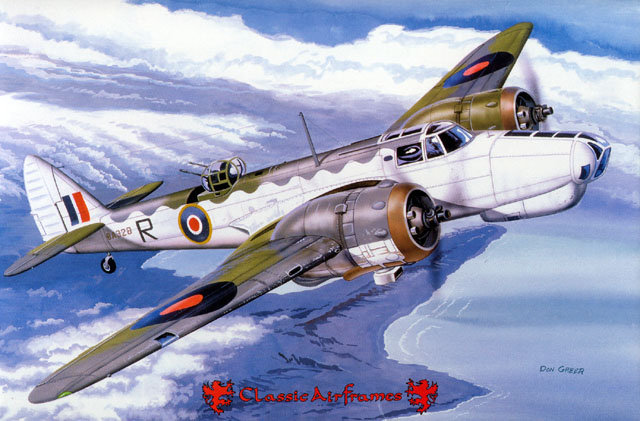

Classic
Airframes' Bristol Blenheim Mk. V is available online from Squadron.com
S
u m m a r y
|
| Catalogue Number: |
437 |
| Scale: |
1/48 |
| Contents and Media: |
Low-pressure injection plastic - 66 grey styrene and 5 clear styrene part. Around 70 parts in pale
cream-coloured resin. 4 parts in clear vacform. Decal sheet with three
marking options. 8 pages of instructions, letter-sized colour marking
guide, two supplementary marking guides in black-and-white. |
| Price: |
Approx. US$55 |
| Review Type: |
In-box |
| Advantages: |
Another interesting subject
otherwise unavailable in this scale; nice surface details; injection
moulded clear canopy (with corrected windscreen rake) and turret parts; excellent resin parts; good
quality decals; clear instructions |
| Disadvantages: |
Some modelling skills required -
parts need cleanup and test-fitting; landing lights not supplied as
clear parts. |
| Recommendation: |
Highly Recommended for experienced
modellers who are fans of early WWII British aircraft. |
Reviewed by
Brett Green
The Bristol Blenheim was already
outclassed at the very beginning of WWII.
By the time the Blenheim Mk.V entered
service in mid 1942, it was hopelessly underpowered compared to its adversaries
in the Mediterranean and Far East theatres. Despite retaining the powerplants of
its predecessor, the "new" Blenheim gained 17 percent in gross weight.
Even so, 940 Blenheim Vs were built and
saw front-line service with 10 Squadrons. Its service record and high attrition
reflected its outdated design and poor performance.
The Blenheim Mk.V may have been a failure in Squadron service, but its rakish
nose, hedgehog exhausts, bulged turret and variety of colour schemes makes it an
attractive subject for modellers.
Classic Airframes' Blenheim Mk.V is their third variant and fourth packaging
of this significant but tragic aircraft. Also available are the Blenheim I in
two boxings and Blenheim IV.
This model shares the majority of parts with last years' Blenheim V. A
detailed review of Classic Airframes'
Blenheim IV/IVF can be found by following this link. This is not a
criticism. The real aircraft shared most of its components with the Mk.IV too.
Fortunately, Classic Airframes have engineered the kit to be adapted to the
final Blenheim variant with a minimum of surgery, and have supplied additional
parts in resin and styrene to finish an accurate Mk. V.
The Blenheim V is packed in Classic Airframe' familiar box with
attractive artwork by Don Greer depicting a Royal Hellenic Air Force machine
As is the usual case with Classic Airframes kits, the main parts of the kit are produced in low-pressure injection plastic.
There are only 66 parts in grey styrene. A handful of these parts are not
required for this version. Plastic is smooth and shiny, while surface detail is impressive. Engraved
panel lines are crisp and fine, and raised detail is present where appropriate.
Fabric surfaces look great.
The new parts for the Mk. V comprise the bulged gear doors, spinner caps
(although they are not applicable for any of the kit's marking options), ventral
gun pack and a new insert for the bulged turret.
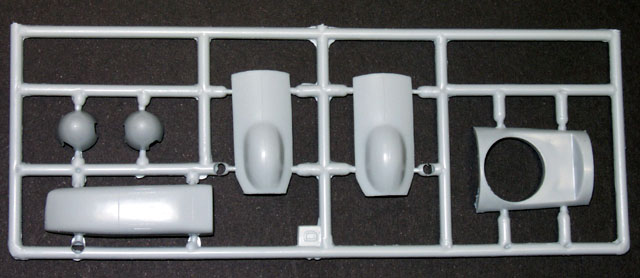
Sprue gates are reasonably narrow for a short-run kit. Flash is not too bad
on my sample, although this will likely vary from kit to kit. Be prepared to
spend some time cleaning up smaller parts in particular. Ejector
pins are present on the inside surface of larger parts. The modeller can easily
remove these if they interfere with fit. There is one big sink mark on the
underside of the trailing starboard wing root. This should be filled and sanded
before assembly.
Some thought has gone into the location of sprue attachment points for the
major parts. The trailing edges of the wings are free of attachment points, and
are quite acceptably thin. Four narrow attachment points run along the bottom of
the fuselage, with a single attachment at the tip of the rudder..
All control surfaces are moulded in the neutral position and cowl flaps are
closed. As per the earlier kits, the prominent landing lights in the
leading edge of the port wing are moulded solid with no option for a clear lens
cover in the kit.
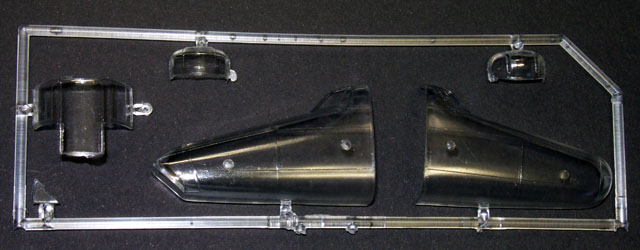
The main clear parts are injection-moulded. They are crisp and very clear,
and supplied separately in a ziplock bag. The long nose looks right, and I was
pleased to see that the rake of the windscreen had been corrected on this
version. The bulged turret is supplied in two pieces. The join is along a frame
line, but extreme care will be required when securing these parts.
The resin parts are gorgeous. Many of these parts are brand new, reflecting
the detail changes to the final variant. New parts include the sidewalls for the
long nose, beautiful hedgehog exhausts, DF loop and more. The plastic parts for
the main exhausts as supplied in earlier kits have been replaced with finer and
more subtly shaed resin parts. Most of the original resin is retained too,
including two lovely Bristol Mercury engines, gear wells, a detailed cockpit, an
array of guns, propeller hubs and other fine details. The resin is crisp and
seems particularly lightweight. This should make it easier to remove some of the
blocks from major parts.
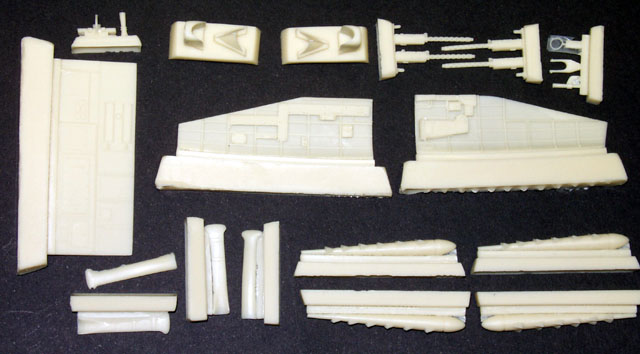
Resin
highlights include the structural detail inside the wheel wells, the drilled-out
gun barrels, and the fine engine detail. A few tiny parts were broken in
transit.
Two vacform parts are supplied for the DF loop housing. The best news about
this is that the two spares can easily be adapted for use as blisters on the
side of the canopy. These blisters are otherwise not supplied as part of the
kit.
The decal sheet includes three marking options. These are printed by Microscale.
The decals appear quite thin and opaque, and they are in perfect register. One
aircraft is a Hellenic Air Force machine finished in Extra Dark Sea
Grey, Slate Grey and Sky. The second machine is a Free French Blenheim in desert
scheme, and the final option (my favourite) is an aircraft with No. 34 Squadron
in Dark Earth, Dark Green and Sky with the red missing from roundels and fin
flashes as a concession to SEA marking requirements.
Click the thumbnails below to view
images full-sized:


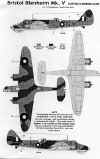
8 pages of instructions include a parts breakdown and 21 construction steps
described in illustrations and helpful captions.
The
general outline of the aircraft looks good. Two of the shortcomings of the
earlier kit have been addressed with the correction of the windscreen angle and
the inclusion of blisters for the side windows (yes, I know, that is not their
intent, but don't look a gift horse in the mouth - its easier than vac-forming
your own).
The contour of the fuselage bottom is still a smooth, shallow curve on
the kit, but displays more of a discernible angle on the real aircraft. This
should not be a serious concern for most modellers.
Engineering is basic but thoughtful. Parts are not fitted with locating pins,
but the major components are quite rigid. This will assist alignment. The
recessed section in the fuselage to accommodate the completed wing assemblies is
also a welcome feature that will help set the correct dihedral and create a
strong bond.
Take note of any comments and warnings in the instructions. There are some
important notes about parts that may need excess material removed, or alternate
construction suggestions.
As with most Classic Airframes kits, careful
preparation and plenty of test fitting should deliver a rewarding result for any
modeller with some experience of limited run kits.
The Blenheim V is a logical choice to round out Classic Airframes' Blenheim
family.
It is nice to see that the detail differences have been addressed with new
styrene and resin parts, and that a couple of shortcomings of the earlier
version have been addressed.
The kit instructions state clearly that this kit is intended for experienced
modellers and that additional time and effort is required. Even so, thanks to
the injection-moulded clear parts and improved engineering, the Blenheim V will be within the capabilities of many HyperScale readers looking for a
challenge.
Highly Recommended.
Thanks to Jules Bringuier of Classic Airframes for
the review sample. Classic Airframes kits are available in Australia via JB
Wholesalers and worldwide through hobby retailers.
Review and Images Copyright © 2001 by Brett
Green
Page Created 20 May, 2001
Last updated 22 July, 2003
Back to HyperScale Main Page
Back to Reviews Page
|
Home | What's
New | Features
| Gallery |
Reviews | Reference
| Forum
| Search